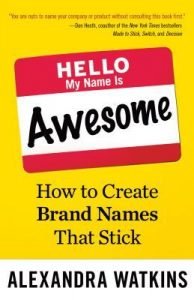Hindsight is awesome, especially if you can put some clever acronyms around it.
Not all the examples highlighted in Hello, My Name Is Awesome: How to Create Brand Names That Stick are convincing. In fact, some are quite opinionated (if not downright self-righteous) and contradictory.
The author exclaimed in chapter 2: “There’s a terribly misguided belief that unique equals creative, which equals great.”
I wished she ate her own dog food because some of her suggestions were treading in that direction.
An example cited by the author is the “clever” way Google named Android versions after sweet indulgences (Cupcakes, Donut, Eclair, Froyo, Gingerbread, Honeycomb, Ice Cream Sandwich, Jelly Bean). The problem is that when you buy a new device, you may not be able to tell if it is running on the latest version of Android. (Yes, it’s alphabetical, but you’ll have to explain that logic to users.) This then falls into the curse of insider knowledge.
Furthermore, the author suggested circling back to “Banana Split, Butterscotch, Cherry Pie, Lemon Bar and Macaroon” for future versions, which would cause confusion for the alphabetical approach.
There are also factual errors. For example, on the part about Do Not Use the Same Name for Your Product and Company, the author asked: “What if Apple had named their first computer the Apple? What would they name the dozens of other products that have launched since then?”
Well, what do you know? Apple did name its first product the Apple Computer, followed by the Apple II, II Plus, and Apple III, all of which are counterexamples of brands violating the author’s “7 Deadly Sins” of naming.
Good thing this is a short book that doesn’t take long to read or I’ll consider it a waste of time.

